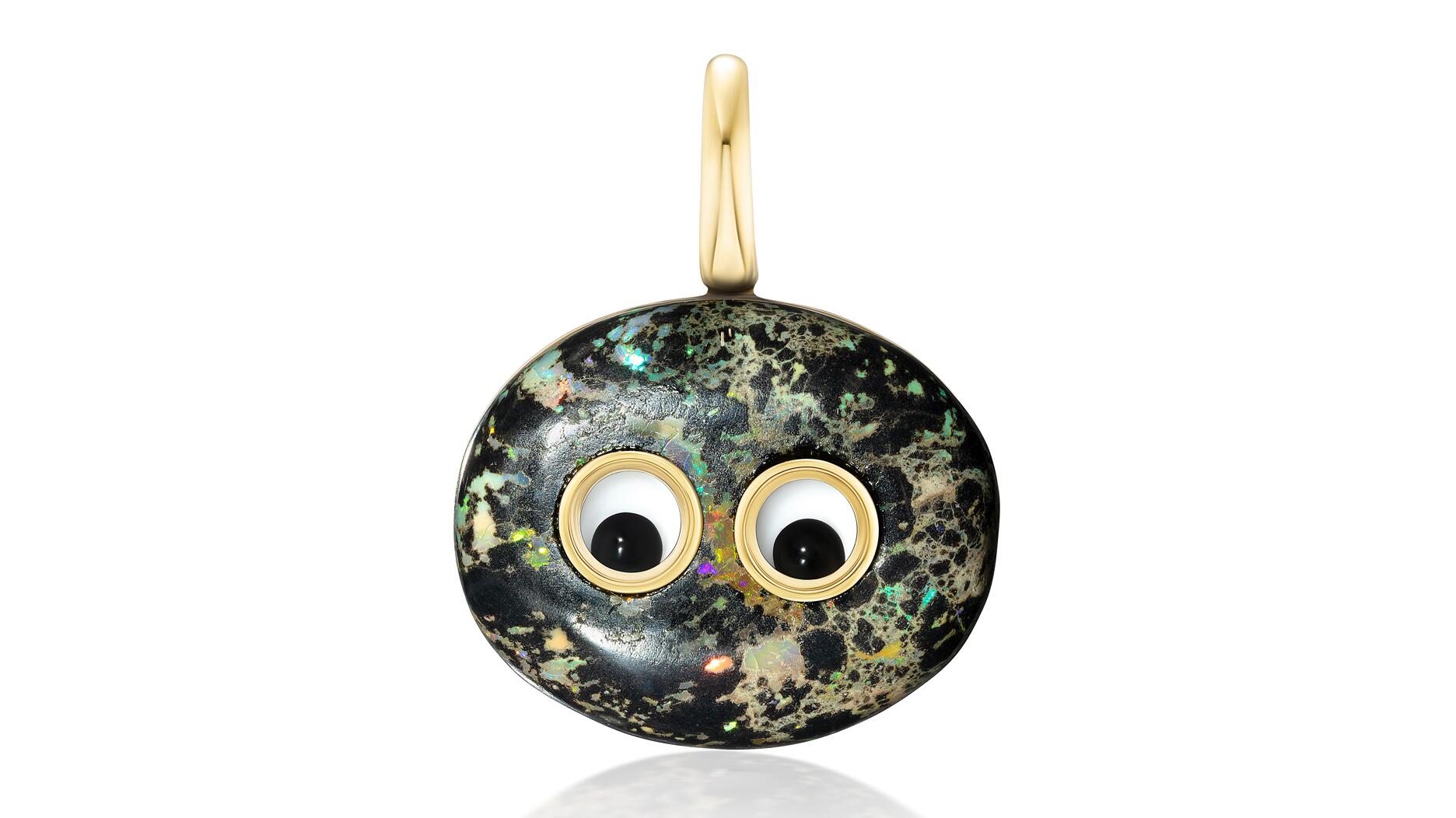The Gemstone World Is In Its Unique Cut Era
Associate Editor Lauren McLemore recently spoke with Columbia Gem House’s Eric Braunwart about the uptick in non-traditional gemstone cuts.

At the HardRock Summit trade show in Denver this month, I saw interesting cuts everywhere. Eric Braunwart, founder of Columbia Gem House, noticed it as well.
Columbia Gem House is one of a handful of companies that has been experimenting with interesting cuts long before this recent trend took hold.
Their gems have trademarked names like “GeoCut,” “Snowflake Cut,” and “Fan Cut,” and many were on display at their booth in Colorado.
While many of the company’s unusual cuts are meant to be experimental, artistic or just interesting to look at, others, like a particular style called the “Woz Cut,” carry more significance.
The Woz Cut is named after an old friend of Braunwart’s who developed the cut about 40 years ago.
Shortly after he started in the business in the late ‘70s, Braunwart met John Wozencraft, who became his friend and at one point, his roommate.
Wozencraft was a gem-cutter, which, Braunwart explained, was not so common in the United States at that time.
“[Wozencraft] was a commercial gem-cutter as opposed to one of the amateur faceters, who are great but spend hours and hours and hours on one stone,” Braunwart said.
Wozencraft once came up with an eight-sided cut with a diamond-shaped table on it, and Braunwart loved it from the start.
“It was very different. Most people didn’t really do fancy shapes 45 years ago. They would do an oval or a round or a pear shape, but they didn’t do fancy shapes,” said Braunwart.
“John specialized in fancy shapes and this was his signature cut.”
While going through some old inventory a year ago, Braunwart found one of Wozencraft’s eight-sided cuts.
“I thought, ‘gosh, I should do something sort of reminiscent of that,’” he said. “So, I’m sure the exact facet pattern isn’t the same, but we call it a Woz Cut because his name was John Wozencraft. It’s a tribute cut.”
Columbia Gem House added the Woz Cut to its inventory 6 months ago.
“It’s nice for me, because I’m looking back over as long as I’ve been doing this and some of the people I’ve worked with and trying to think of things that remind me of them and this definitely did,” Braunwart said.
“I really loved [the cut] then and I like it now, and people seem to like it now too.”
A while back, Wozencraft moved to Bangkok, Thailand, to bring his fancy cutting skills to that area of the world, and he lived there for some time. He and Braunwart eventually lost touch.
“Maybe if this thing gets out there, then he’ll call me!” Braunwart said hopefully.
Columbia Gem House has used the Woz Cut on various gemstones, including sapphire, spinel, amethyst, tourmaline, and, for bigger sizes, quartz. The octagonal cut can be made into a square cushion shape or lengthened into more of an elongated cushion.
“We may get these long crystals of neon-green beryl or aqua or tourmaline, and by taking that Woz Cut and stretching it out, we can do a very long stone,” Braunwart said. “We’ve cut some that are 18 millimeters by 5 millimeters, like really long stretched out ones.”
The ability of this cut pattern to be “stretched” (as seen below) can have practical aspects also.
“It better utilizes the rough and creates a very interesting, unusual stone,” Braunwart said.
Proprietary cuts and custom carvings always have been enticing for designers or consumers looking for something truly one-of-a-kind, and true creativity and skill in this area long has been a celebrated art.
The American Gem Trade Association’s Spectrum and Cutting Edge Awards have been around since the 1980s.
But lately, it’s not uncommon to see some dealers keeping an assortment of unique-cut pieces stocked in inventory.
Columbia Gem House has a secret weapon when it comes to unusual cuts.
The U.S.-based company first set up its own managed cutting factory in China around 40 years ago, which allows it to experiment with production.
For example, Columbia Gem House can offer the Woz Cut in calibrated sizes, rather than it being limited to a one-of-a-kind cut likely used in a limited-edition piece.
It’s a good time to have such an operation.
“There’s a big demand for unusual cuts right now,” Braunwart said, adding that he believes the demand is also unique to the U.S.
“I would be very surprised if I could go and sell them in India or China or something like that; there, I think they want the more standard cushions, ovals and pear shapes.”
One particular thing that sets apart many, though certainly not all, of the trending unusual cuts from most standard cuts is a faceted girdle, which Braunwart said tends to be harder to set versus a soft, curved girdle like a cushion.
It’s especially difficult with prongs, because the sharp angular aspect of the feature increases the risk of chipping.
Cutting the faceted girdle is more work, and it takes more time. If a company doesn’t have Columbia Gem House’s level of managed cutting production overseas, there is another place these gemstones likely are coming from—American cutters.
“America has some of the best cutters in the world [and] most of them are one-of-a-kind cutters,” Braunwart said.
In the past, these cutters weren’t really a practical option for larger companies with big inventories. It made more sense from a volume, time and cost perspective to buy mostly from production cutters overseas and leave only the custom, finer work to be done in the U.S.
“If you’re cutting in Thailand, you’re cutting for the Middle East, Europe, China, you’re going to do whatever is the most common denominator—rounds, ovals, pear shapes, etc. They don’t do a lot of calibrated fancy cuts,” Braunwart said.
Things appear to be changing, though. One of Braunwart’s theories for why these unique cuts seem more common now is the increase in the number of American-cut stones on the market.
“Some of [the American cutters] are starting to do a little bit of production cutting where they’ll do 12 to 15 [unique-cut] stones a week that might all be different stones, but generally all will have faceted girdles,” Braunwart said.
While jewelry setting may remain a bit of a challenge for the faceted girdle cuts, I’m excited about the prospect of more unusual cuts becoming available.
Even though some companies like Columbia Gem House are able to mass-produce calibrated sizes of some cuts, I think these cuts are still different enough to give consumers that unbeatable feeling of having something unique.
All this talk of the new unique cuts on the market also has me really excited to see this year’s entries for the 2023 Spectrum Awards, for which the submission deadline recently was extended.
The Latest

The couple pleaded guilty to concealing at least $127 million in cash transactions at its precious metals businesses.

Consumers shared concerns about prices, inflation, tariffs, trade, and politics in the survey’s write-in response section.

In February 2026, the auction house will move its headquarters to the former Steinway Hall, a neoclassical landmark on Billionaires’ Row.

How Jewelers of America’s 20 Under 40 are leading to ensure a brighter future for the jewelry industry.

The new show will take place Jan. 23-25, 2026.


The former BHP Billiton leader and Gemfields chairman is remembered for his influential leadership throughout his 50-year mining career.

The LVMH-owned brand has partnered with the costume design union to revamp its award for 2026.

Roseco’s 704-page catalog showcases new lab-grown diamonds, findings, tools & more—available in print or interactive digital editions.

The luxury titan inked a deal to acquire an initial minority stake in the jewelry manufacturer with a pathway to full ownership by 2032.

The company’s curation of unsigned vintage and estate jewelry debuted at the Bloomingdale’s in Costa Mesa, California.

In the recent multi-shipment seizure, CBP also found counterfeit Audemars Piguet, Moncler, and Chrome Hearts items.

Jewelers of America execs and National Jeweler editors discuss tariffs, the sky-high gold price, and the engagement that broke the internet.

The luxury goods company said founder Ippolita Rostagno will remain at the brand’s helm.

Laura Burdese, who joined the Italian luxury brand in 2022, will take on the role in July.

Need a gift for the cat lover who has everything? Look no further than our latest Piece of the Week.

It purchased the “Grosse Pièce,” an ultra-complicated Audemars Piguet pocket watch from the ‘20s, for a record-breaking price at Sotheby’s.

The lab-grown diamond grower now offers custom engagement and fashion jewelry through its Kira Custom Lab Jewelry service.

Chandler got his start at Michelson Jewelers and has served as DCA president and CEO since 2001. He will retire at the end of the month.

The boutique is slated to open this week inside Terminal 8, offering pre-owned Rolex watches and more to international travelers.

Sponsored by Digital Monitoring Products

The special-edition egg pendant ingested in a New Zealand jewelry store was recovered after a six-day wait.

Associate Editor Natalie Francisco plays favorites with Piece of the Week, selecting a standout piece of jewelry from each month of 2025.

The “Love and Desire” campaign is inspired by the magic that follows when one’s heart leads the way, said the brand.

Two awardees will receive free tuition for an educational course at the Swiss lab, with flights and lodging included.

Berta de Pablos-Barbier will replace Alexander Lacik at the start of January, two months earlier than expected.

Sotheby’s held its first two jewelry sales at the Breuer building last week, and they totaled nearly $44 million.

Winners will receive free registration and lodging for its fourth annual event in Detroit.




























